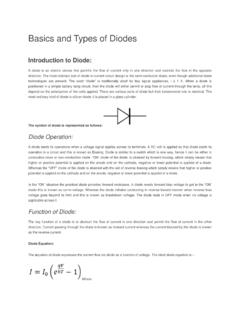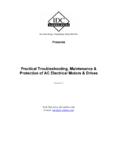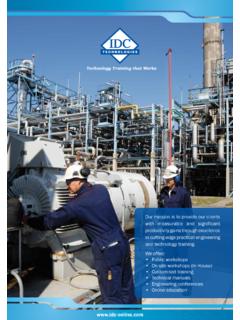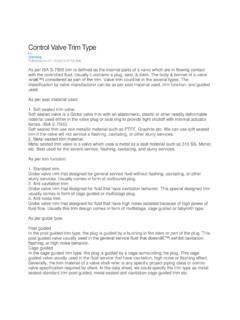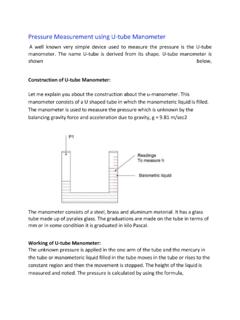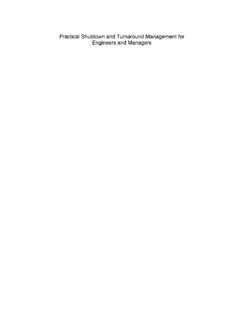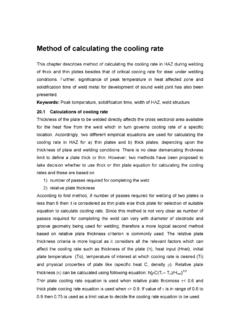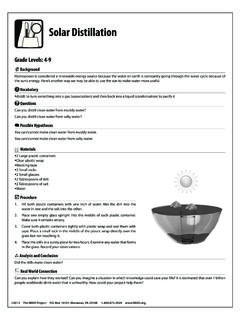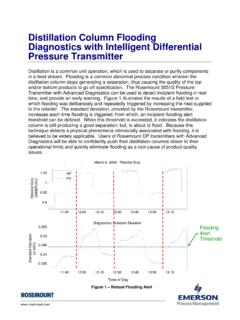Transcription of Distillation Process - IDC
1 Distillation Process Distillation separates two or more liquid components in a mixture using the principle of relative volatility or boiling points. The greater the difference in relative volatility the greater the nonlinearity and the easier it is to separate the mixture using Distillation . The Process involves production of vapour by boiling the liquid mixture in a still and removal of the vapour from the still by condensation. Due to differences in relative volatility or boiling points, the vapour is rich in light components and the liquid is rich in heavy components. Often a part of the condensate is returned (reflux) back to the still and is mixed with the outgoing vapour. This allows further transfer of lighter components to the vapour phase from the liquid phase and transfer of heavier components to the liquid phase from the vapour phase.
2 Consequently, the vapour stream becomes richer in light components and the liquid stream becomes richer in heavy components. Different types of devices called plates, trays or packing are used to bring the vapour and liquid phases into intimate contact to enhance the mass transfer. Depending on the relative volatility and the separation task ( purity of the separated components) more trays (or more packing materials) are stacked one above the other in a cylindrical shell to form a column. The Distillation Process can be carried out in continuous, batch or in semi-batch (or semi-continuous) mode. Continuous Distillation Figure shows a typical continuous Distillation column. The liquid mixture (feed), which is to be separated into its components, is fed to the column at one or more points along the column.
3 Liquid runs down the column due to gravity while the vapour runs up the column. The vapour is produced by partial vaporisation of the liquid reaching the bottom of the column. The remaining liquid is withdrawn from the column as bottom product rich in heavy components. The vapour reaching the top of the column is partially or fully condensed. Part of the condensed liquid is refluxed to the column while the remainder is withdrawn as the distillate product. The column section above the feed tray rectifies the vapour stream with light components and therefore is termed as rectlfying section. The column section below the feed tray strips heavy components from the vapour stream to the liquid stream and is termed as stripping section. The readers are directed to Smith (1963), Seader and Henley (1998), Perry et al.
4 (1997), McCabe et al. (2001), Gani and co-workers (1986a, 1986b, 1988, 2000), Perkins and co-workers (1996, 1999,2000, 2001) for detailed account of modelling design, operation, control and synthesis of continuous Distillation processes. Batch Distillation Batch Distillation is, perhaps the oldest operation used for separation of liquid mixtures. For centuries and also today, batch Distillation is widely used for the production of fine chemicals and specialised products such as alcoholic beverages, essential oils, perfume, pharmaceutical and petroleum products. It is the most frequent separation method in batch processes (Lucet et al., 1992). The essential features of a conventional batch Distillation (CBD) column (Figure ) are: A bottom receiverheboiler which is charged with the feed to be processed and which provides the heat transfer surface.
5 A rectifying column (either a tray or packed column) superimposed on the reboiler, coupled with either a total condenser or a partial condenser system. A series of product accumulator tanks connected to the product streams to collect the main and or the intermediate distillate fractions. Operation of such a column involves carrying out the fractionation until a desired amount has been distilled off. The overhead composition varies during the operation and usually a number of cuts are made. Some of the cuts are desired products (main-cuts) while others are intermediate fractions (off-cuts) that can be recycled to subsequent batches to obtain further separation. A residual bottom fraction may or may not be recovered as product (Mujtaba, 1989). Semi-batch (semi-continuous) Distillation Figure shows a typical semi-batch (semi-continuous) Distillation column.
6 The operation of such columns is very similar to CBD columns except that a feed is introduced to the column in a continuous or semi-continuous mode. This type of column is suitable for extractive Distillation , reactive Distillation , etc. (Lang and co- workers, 1994, 1995; Mujtaba, 1999). source: Batch Distillation Design and Operation, by Mujtaba University of Bradford, UK Source.
